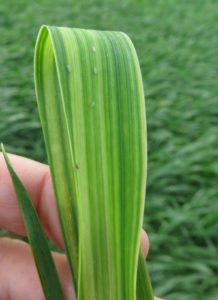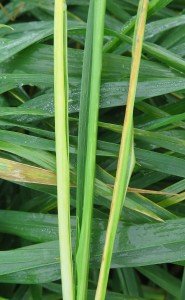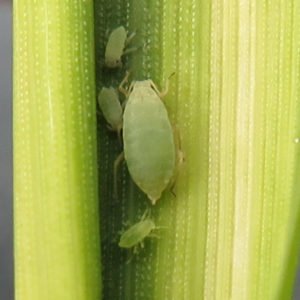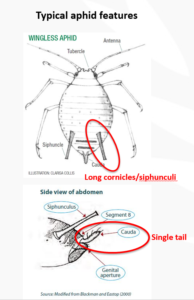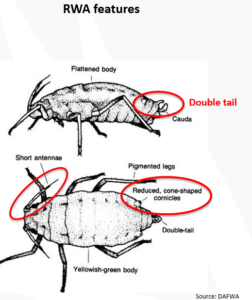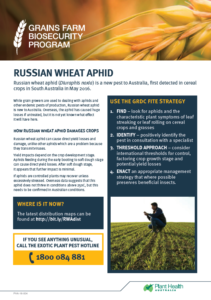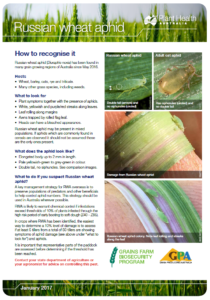Russian wheat aphid (RWA) is considered a high priority pest by the grains industry because of its potential to cause significant yield losses in wheat and barley if not well managed. Triticale and rye are also susceptible to crop loss, but oats are considered relatively tolerant.
It is inevitable that RWA will establish in the northern grains region, but we don’t know when we will start to see it in crops. Given how widely distributed RWA is in South Australia and Victoria, it seems likely that RWA has been in Australia for some time prior to the 2016 outbreak. Environmental conditions that favoured the southern region’s outbreak were a wet summer (abundance of summer hosts), a warm autumn (encouraged rapid population growth), and early sowing of winter cereals (allowed movement from weed hosts to crops).
In addition to crop hosts, non-crop and pasture grass species in the genera Poa, Bromus, Hordeum, Lolium, and Phalaris may also host RWA. It remains to be seen whether RWA are more likely to over-summer on grass hosts or crops (e.g. sorghum, maize, millet, canary) in the cropping landscape.
The RWA is more damaging to cereals that the aphid species we already have in Australia. We don’t yet know how susceptible Australian varieties are to RWA; GRDC is currently investing in the development of resistant cultivars. In the meantime, international experience has been that yield losses are generally lower in seasons following RWA outbreaks, as growers are better equipped to detect and manage infestations, and natural enemies establish and contribute to the suppression of populations. In South Australia and Victoria in 2016, early infested crops that were treated to control RWA recovered to grow and yield normally.
In the 2017 season, it is important that crops are monitored more frequently than they might usually be to ensure early detection of RWA, should it occur.
Sample for RWA in the same way you would sample for other cereal aphids. Concentrate on the field margins and in areas of the paddock that are stressed (dry, wet, root disease). Look for both plant symptoms (see description below) and the presence of aphids.
The following thresholds are recommended:
- Emergence to tillering: 20 RWA per plant
- Tillering onwards (Z30-59): 10 aphids per tiller
If control of RWA is warranted, there is a current Emergency Use Permit (APVMA PER82792) for chlorpyrifos and pirimicarb. Pirimicarb is selective (will kill aphids, but not the beneficial insects in the crop), so if possible, use this option first to preserve beneficials that may then suppress further outbreaks.
Leaf symptoms caused by RWA infestations – what to look for in the field
RWA induce striking symptoms in wheat and barley, unlike the oat and corn aphid which produce no obvious symptoms. Plants will start to exhibit symptoms within a week or so of being infested, and plant damage is in response to direct aphid feeding, so only the leaves and/or tillers that are infested will show symptoms.
1. White streaking of the leaves. Some varieties show reddening.
2. Rolled leaves. RWA colonies shelter inside the rolled leaves.
Some of these symptoms are similar to those caused by wheat streak mosaic virus (WSMV) and phenoxy damage in cereals, so closely examine plants to confirm the presence of RWA.
Distinguishing RWA in the field
Use a hand lens to check for key features (see below), specifically for the absence of siphunculi and the double tail (cauda), characteristic of RWA.
Links to further information on RWA in Australia
- Plant Health Australia (Fact sheets, contingency plans, diagnostic protocols)
- NSW DPI Plant Biosecurity
- Pestfacts SA. Overview of RWA outbreak in 2016. SARDI (South Australia)
A slideshow of this information is available on our presentations page.

